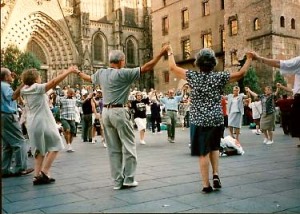Capitalism and dance do not mix. No matter who you are on Earth, look around you, and you’ll see that you live in a culture of dancing, or you exist within the influence of capitalism. Never do both thrive simultaneously.
Culture is our immune system. It keeps us strong and vibrant. It connects us to a community with the healthful consequences that come with that bond. Dance is one of the indicators of this system’s strength; it is the rosy hue of our complexion, the fire in our eyes, the strength of our stride. If you need a quick summation of a culture’s vitality, you only require the answer to one question: do the people dance? Capitalism aims to penetrate the social body. It is a pathogen that sees only one role for the organism it invades: a host for itself. The virus has no respect for the welfare of the being that it usurps; it desires only infection of that body and contagion to the next. It feeds off the host, sapping it of vigour, exhausting the muscles, straining the being in unseemly ways. Now, fever overtakes us, the sickly. We rush to work, speed to the next mall sale. Sirens blare in the night. Prisons are filled. Pink slips are issued. Now, delirium accosts us. Political campaigners, advertisers and agents of public relations garble delusional messages into our ears. Finally tiredness overcomes us. Television, alcohol, drugs, and fluffy internet apps send us into our stupor.
The immune system activates to counter this onslaught. But it struggles. Native peoples of European settler countries suffer the inevitable, dire poverty of modern capitalist “development” while they dance for their very cultural lives. On the Iberian peninsula, birthplace of the flamenco, the fandango, the paso doble, the bolero and the sardana, the capitalist bug completed its infection after taking advantage of a crippled immune system. The cultures of the Basques, Catalans, Andalusians and others were squashed by the goose-stepping Spanish fascists in the 1930’s, dance shoes being no match for jackboots. This pattern repeats globally. Governments the world over—“democratic,” or totalitarian—use State toxins to weaken the immunity of the social body for the benefit of the capitalist contagion.
The State-assisted capitalist epidemic broke out first in the British Isles with its industrialization and merchant trading. And now almost no one in those ancient lands know the steps to the jig, the reel, the fling, the strathspey, or the Morris dance any more. Dances of central Europe and Germany—the schuhplattler, the ländler, the waltz, the polka—suffered a loss of vitality soon afterwards. And similarly, we see the virus sweeping across 21st century China as the mechanical Han Chinese produce coal mines and factories, condominiums and brand-name apparel, with nary a bounce in their step. In all of these countries dance primarily exists in two forms. It becomes a theatre show for viewing, a spectacle to watch but not for doing. Put in a petri dish and swirled around. Or young party-goers flail about desperately in nightclubs, alcohol sloshing within their bellies, in decidedly un-cultural ways.
To be sure, on occasion new dance styles are invented such as hip hop and jumpstyle on the streets and in the clubs. But they struggle to revive the culture and often fade out after some time. Or the contagion immerses them, and they become assimilated by capitalist forces. One of the greatest dancers in modern times, Michael Jackson, rose up from meagre origins, realized great financial success, and promptly forgot how to create new steps. A rose emerged from the dirt, swayed and fluttered attractively to the rhythm of the wind, and was plucked crudely for the businessman’s lapel.
But maybe there is hope yet. The Greeks, perhaps the only Western Europeans to maintain dear feelings for dance, those people of hundreds of styles, muster some resistance to the International Monetary Fund and other bullying financial organizations–while commentators laughably write, “The Greeks’ innate anti-authoritarianism… is at the heart of the problem.” The capitalist pathogen surrounds Cuba seeking a vector into that lively organism while the defenders conjure up the cha-cha, summon the spirit of the salsa, and invoke the magic of the mambo for protection. The samba-loving Brazilians and tango-strutting Argentines resist international capitalist pressures. The Bolivians with their caporales, morenada, kullwada, diablada, and countless other dances gyrate, bounce, and skip an anti-globalization president into office. How wonderful that some refuse to march in step.
Anarchist Emma Goldman once said: If there won’t be dancing at the revolution, I’m not coming. I can tap my foot to that tune.



